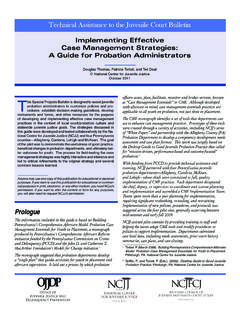Transcription of OFFICE OF JUVENILE JUSTICE AND DELINQUENCY …
1 The field of JUVENILE corrections has experienced numerous improvements over the past few decades. Much has changed as the field has embraced evidence-based practices and focused on the delivery of treatment and other services to improve youth and system outcomes. JUVENILE correctional administrators rely on accurate and timely data to ensure facility practices and operations reflect evidence-based practices and are aligned with their rehabilitative missions. For example, knowing criminogenic risk levels and needs of youth can assist with individual treatment planning, while the same data in the aggregate can help plan the range of services available to youth. Knowing the proportion of youth who reoffend or return after release provides administrators with a measurable outcome to assess performance and make improvements. Here are five important ways that JUVENILE correctional administrators can use data:Ensure safety of youth and staff JUVENILE correctional administrators are responsible for the safety and security of the youth and staff in their facilities.
2 Safe facilities allow youth and staff to focus on achieving treatment and rehabilitation goals. JUVENILE correctional administrators can collect and analyze data on assaults and injuries to monitor facility safety and the use of isolation and restraints to gauge the overall quality of life for those living and working in the facility. For example, knowing the duration and type of isolation events or the frequency and reason for use of restraints can help administrators understand the nature and extent of these practices and inform decisions regarding staffing levels, supervision practices, staff training needs, and programming services are benefiting youth JUVENILE correctional facilities are designed to hold youth accountable while providing programming options to develop pro-social skills. Data on services completed by youth and demonstrable behavior changes can help administrators determine if services are benefitting youth. For example, analyzing data on academic achievements of youth, such as progress in literacy and math, can provide administrators valuable information about the facility s educational services.
3 Similarly, knowing the proportion of youth who participate in and complete treatment, as well as those who demonstrate acquired skills and behaviors can help determine whether treatment options are meeting the needs of the fair practices Youth who believe that they are treated fairly by JUVENILE correctional facilities show a reduction in system involvement and antisocial activity (National Research Council, 2013). Therefore, correctional administrators have a keen interest in ensuring facility practices are fair and that rules are applied equally to all youth. Data can support these efforts. For example, surveys administered to youth and families can provide insight into their experiences and perceptions of fairness. Looking at the frequency of disciplinary actions or incentives given for good behavior by youth characteristics ( race) can provide administrators more information on how often and consistently these practices are used and serve as a means to monitor, evaluate, and influence positive facility culture Ways State JUVENILE Correctional Administrators Can Use DataOFFICE OF JUVENILE JUSTICE AND DELINQUENCY PREVENTION JUVENILE JUSTICE MODEL DATA BRIEF0102 SHARON HARRIGFELD DIRECTOR, IDAHO DEPARTMENT OF JUVENILE CORRECTIONSNATIONAL COUNCIL OF JUVENILE AND FAMILY COURT JUDGES | NATIONAL CENTER FOR JUVENILE JUSTICE03 JUVENILE JUSTICE has become data-driven.
4 We use historical placement and length of custody data along with offense and risk-level data to create profiles of the juveniles we see in custody and what worked best in the past. We apply that information for service planning with commitments. Placement and length of custody are determined from recidivism data while still allowing for professional discretion from our knowledgeable clinical supervisors. Additionally, we ve noticed an increase in juveniles with trauma and using that data we ve created the Trauma Informed Care Initiative to teach staff how to work with juveniles that have experienced trauma. We use data to make informed decisions to give the juveniles the best opportunities to become productive citizens. Monitor practice improvements As research continues to inform the field, correctional administrators make improvements to policy and protocols to align with best practices, incorporate the developmental approach and improve experiences and outcomes for youth in their care.
5 It is important to know if these changes are implemented as designed and accomplishing their intended outcomes. For example, if a facility implements a behavioral health screening tool at intake, administrators should know what proportion of staff have been trained in its administration, what proportion of youth are screened in accordance with policy, and the proportion of youth referred for further assessment who were assessed within the specified timeframe. This type of information helps administrators monitor the implementation of improvements and understand their project was supported by Grant No. 2015-JF-FX-K003 awarded by the OFFICE of JUVENILE JUSTICE and DELINQUENCY Prevention, OFFICE of JUSTICE Programs, Department of JUSTICE . Points of view expressed in this document are those of the author(s) and do not necessarily represent the official position or policies of OJJDP or the Department of Teri Deal, Senior Research Associate Email: Phone: 412-246-0846 PROJECT DESCRIPTION The OJJDP JUVENILE JUSTICE Model Data Project aims to enhance the quality and consistency of JUVENILE JUSTICE information and to increase its appropriate use in policy and practice decisions by providing guidance to states and jurisdictions on data improvements.
6 The Model Data Project is a collaboration between the OFFICE of JUVENILE JUSTICE and DELINQUENCY Prevention, the National Council of JUVENILE and Family Court Judges, the National Center for JUVENILE JUSTICE , the International Association of Chiefs of Police (IACP), the American Probation and Parole Association (APPA), the Council of JUVENILE Correctional Administrators (CJCA), the Performance-based Standards Learning Institute (PbS), and researchers from the Florida Department of JUVENILE JUSTICE (FLDJJ).0405 NATIONAL COUNCIL OF JUVENILE AND FAMILY COURT JUDGES | NATIONAL CENTER FOR JUVENILE JUSTICESUGGESTED CITATION Wachter, A. and Deal, T. (2017). 5 Ways JUVENILE Correctional Administrators Can Use Data. Pittsburgh, PA: National Center for JUVENILE efficiency JUVENILE correctional facilities are asked to accomplish many goals, often with limited budgets and resources. Therefore, it is important that facilities operate efficiently.
7 Administrators should understand the financial costs of operating a facility, including the cost per day of placement and costs associated with research and planning. They should consider the cost of programming, including expenses for training, quality assurance, materials, and staff. This helps support data-informed decisions about how to allocate resources and connect youth with services that successfully meet their needs. Facilities that contract for services should require data that demonstrate program accountability, including the number of youth actively participating, the duration (hours) of programming, the number of youth demonstrating new skills, and those successfully completing programming. Successful competition should be specifically defined for each program and may include expectations for number of sessions attended and level of engagement (participation) in planned FORBES COMMISSIONER, MASSACHUSETTS DEPARTMENT OF YOUTH SERVICESAt the Massachusetts Department of Youth Services we use data to guide our operations.
8 We measure activities and outcomes at the youth, program and system levels. This approach allows us to make informed decisions about the programs that we prioritize for funding and support. We use data to measure positive outcomes including education and employment attainment by youth. We also use data to monitor safety indicators including our use of restraint and room confinement. On a regular basis we are able see where we are making progress and where we may need to provide strategic support to a residential program that may be struggling. We regularly share data with our management team and throughout our workforce to keep people on board with the fact that we are accountable to produce positive youth outcomes and operate safe programs. REFERENCES National Research Council. (2013). Reforming JUVENILE JUSTICE : A Developmental Approach. Committee on Assessing JUVENILE JUSTICE Reform, Richard J. Bonnie, Robert L. Johnson, Betty M.
9 Chemers, and Julie A. Schuck, Eds. Committee on Law and JUSTICE , Division of Behavioral and Social Sciences and Education. Washington, DC: The National Academies Press.








